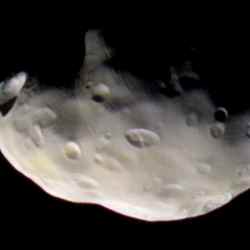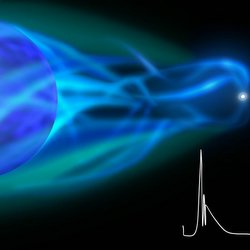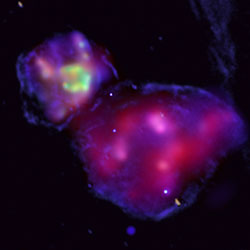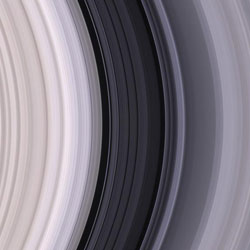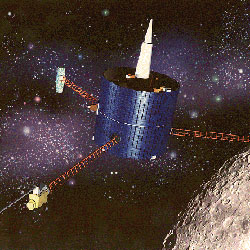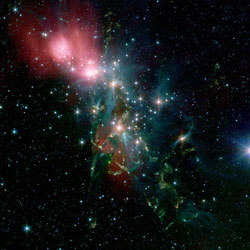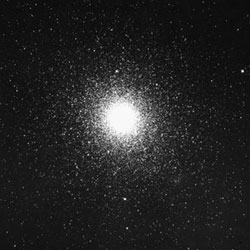
47 Tucanae. Image credit: NOAO/AURA/NSF. Click to enlarge.
Monday, November 14 – Tonight we salute our friends in the Southern Hemisphere as we start by having a look at the ninth brightest star in the sky – Achernar. Better known as Alpha Eridanii, this hot, blue giant is considered to be an “Orion-type” and is around 120 light years away. As you view it in binoculars, shift southwest for one of the most spectacular globulars in the heavens – 47 Tucanae.
First noted by LaCaille in 1755, this spectacular “ball of stars” comes through at a moonlight defying magnitude 4.5. As one of the nearest of all globular clusters, 47 Tucanae is also unusual because it contains a higher abundance of metal atoms – leading science to believe it is far younger than most of its type. Even the smallest of telescopes will have no problems beginning resolution on this Class III study, but for those with large aperture? Be prepared to be swept away 16,000 light years into its beauty…
Tuesday, November 15 – It’s officially Full Moon once again. Native American legend refers to this as the Full Beaver Moon. Because the North Hemisphere climate is now turning rather chilly, it became the time to set beaver traps before the swamps froze. This guaranteed trappers supply of warm furs to help survive the winter months. Some also believe that the Beaver Moon may have also been so named for the beavers themselves, who are readying their homes for the coming cold. No wonder this is sometimes called the Frosty Moon as well!
And frosty is just how the Moon will appear to binoculars or telescopes. Look at both the west and eastern limbs. Is the Moon truly “Full” tonight, or can you still see a bit of the terminator?
Today also marks a very special birthday in history. On this day in 1738, William Herschel was born. Among this British astronomer and musician’s many accomplishments, Herschel was credited with the discovery of the planet Uranus in 1781, the motion of the Sun in the Milky Way in 1785, Castor’s binary companion in 1804 and infrared radiation. Herschel was well known as the discoverer of many clusters, nebulae, and galaxies. He spent countless years studying the night sky and writing catalogs whose information we still use today. Tonight let’s look towards Cassiopeia as we remember this great astronomer!
Everyone knows that Queen Cassiopeia is bound to her chair and destined to turn over and over in the sky, but did you know this constellation holds a wealth of double stars and galactic clusters? Seasoned sky watchers have long been familiar with its many delights, but let’s begin our exploration of Cassiopeia with two of its primary stars.
Looking much like a flattened “W”, the southern-most bright star is Alpha. Also known as Schedar, this magnitude 2.2, spectral type K star, was once suspected of being a variable, but no changes have been detected in modern astronomy. Binoculars will reveal its orange/yellow coloring, but a telescope is needed to bring out its unique features. In 1781, Sir William Herschel discovered a 9th magnitude companion star and our modern optics easily separate the blue/white component’s distance of 63″. A second, even fainter companion at 38″ is mentioned in the list of double stars and even a third at 14th magnitude was spotted by S.W. Burnham in 1889. All three stars are optical companions only, but make 150 to 200 light year distant Schedar a delight to view!
Just north of Alpha is the next destination for tonight – Eta Cassiopeiae. Discovered by Sir William Herschel in August of 1779, Eta is quite possibly one of the most well-known of binary stars. The 3.5 magnitude primary star is a spectral type G, meaning it has a yellowish color much like our own Sun. It is about 10% larger than Sol and about 25% brighter. The 7.5 magnitude secondary (or B star) is very definitely a K-type, metal poor, and distinctively red. In comparison, it is half the mass of our Sun, crammed into about a quarter of its volume and around 25 times dimmer. In the eyepiece, the B star will angle off to the northwest, providing a wonderful and colorful look at one of the season’s finest!
Wednesday, November 16 – Today in 1974, there was a party at Arecibo, Puerto Rico and the new surface of the giant 1000-foot radio telescope was dedicated. At this time, a quick radio message was released in the direction of the globular cluster M13.
Tonight nap away the early evening time, because within hours the Leonid meteor shower will be underway. For those of you seeking a definitive date and time, it doesn’t always happen. The degree of the meteor shower itself belongs to the debris shed by comet 55/P Tempel-Tuttle as it passes our Sun in its 33.2 year orbital period. Although it was once assumed that we would merely add around 33 years to each observed “shower”, we later came to realize the debris formed a cloud that lagged behind the comet and dispersed irregularly. With each successive pass of Tempel-Tuttle, new filaments of debris were left in space as well as the old ones, creating different “streams” the orbiting Earth would cross through at varying times making blanket predictions unreliable at best.
Each year during November, we pass through these filaments – both old and new – and the chances of impacting a particular “stream” from any one particular year of Tempel-Tuttle’s orbit becomes a matter of mathematical equations. We know when it passed… We know where it passed… But when will we encounter it and to what degree? Traditional dates for the peak of the Leonid Meteor shower occur as early as the morning of November 17 and as late as November 19. But, what about this year? On November 8, 2004 the Earth passed through an ancient stream shed in 1001. Predictions ran high for viewers in Asia, but the results turned out to be a dud. There is no doubt that we crossed through that stream, but its probability of dissipation is incalculable. Debris trails left by the comet in 1333 and 1733 look the most promising, but we simply don’t know.
We may never know precisely where and when the Leonids might strike, but we do know that a good time to look for this activity is well before dawn on November 17, 18 and 19th. With the Moon mostly full, it’s going to trash the skies, but wait until the radiant constellation of Leo rises and the chances are good of spotting one of the offspring of periodic comet Tempel-Tuttle.
Thursday, November 17 – On this day in 1970, long running Soviet mission, Luna 17, successfully landed on the Moon. Its Lunokhod 1 rover became the first wheeled vehicle on the Moon. It was designed to function three lunar days, but operated for eleven. The machinations of Lunokhod officially stopped on October 4, 1971, the anniversary of Sputnik 1. The rover had traversed 10,540 meters, transmitted more than 20,000 television pictures, over 200 television panoramas and performed more than 500 lunar soil tests. Spaseba!
Tonight while keeping your Leonid watch, you can view the Luna 17 landing area with ease in either binoculars or telescopes. Wait until the rising Moon as cleared most atmospheric disturbance and look in the northwest quadrant for previous study – the C-shaped Sinus Iridum. The most western tip of the “C” is Promentorium Heraclides and Lunokhod 1 traveled along the smooth “Sea of Rains” just a breath southwest of this point.
Friday, November 18 – Keep watching for the Leonids tonight as we head out before the Moon rises to view Alpha Capricornii. Binoculars should have a look at 3.8 magnitude Algedi and its widely spaced, 4.0 magnitude companion. Both stars are solar spectra types (G stars) – but that’s where their resemblance to our Sun ends. These two are yellow giants… A rare alignment of two bright stars. They are not a true binary. Alpha 1 is 690 light-years distant while Alpha 2 is six times closer.
If you brought your scope out tonight, challenge yourself to Pi Capricornii. Look for an 8.5 magnitude companion 3.2 arc seconds southeast. Pi is the more southerly of two stars south of Alpha.
Saturday, November 19 – With early dark skies, let’s return to Cassiopeia for a small scope study of two open clusters in the same field of view. Starting at northwestern Beta, look less than two fingerwidths northwest for pair NGC 7790 and NGC 7788. Southern NGC 7790 is a fairly large 8.5 magnitude cluster composed of two dozen scattered, faint stars. Northern NGC 7788 is roughly half the size of its companion and slightly fainter. It contains a mixed magnitude of faint stars at high power. A small scope should resolve out an arrowhead-shaped region in this cluster.
For binocular observers, head out to the “Double Cluster” and look only a fingerwidth north. Like many fine deepsky studies which accompany grander partners, you’ll find Stock 2 suprisingly impressive. This degree wide, magnificent cluster is often overlooked, but take the time to appreciate its many magnitudes and delightful asterisms.
Sunday, November 20 – Today also celebrates another significant astronomer’s birth – Edwin Hubble. Born 1889, Hubble became the first American astronomer to identify Cepheid variables in M31 – which in turn established the extragalactic nature of the spiral nebulae. Continuing with the work of Carl Wirtz and Slipher’s redshifts, Hubble then could calculate the velocity-distance relation for galaxies. This is known as “Hubble’s Law” and demonstrates the expansion of our Universe.
Tonight we’ll have early dark skies, and what time to celebrate Hubble’s achievements. Let’s turn our binoculars or scopes towards two of the finest spiral nebulae – one for the northern hemisphere and one for the southern.
For the north, look one degree west of Nu Andromedae for the M31. This magnitude 5.0 spiral galaxy and all of its richest are easily viewed with the smallest of binoculars to the largest of telescopes.
Echoing it less than a fistwidth south of Beta Cetii is the equally grand NGC 253. While this wonderful galaxy is around one quarter the size of the M31 and dimmer at magnitude 7.0, it is no less lacking in terms of observational structure. Power up and look for a bright, dense central mass as well as patchiness that denotes distant clusters, dark dust and nebulae.
Until next week and darker skies… May all your journeys be at light speed! ~Tammy Plotner
